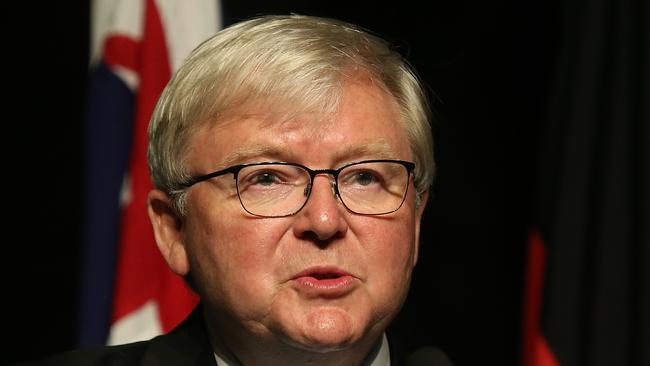
The Liberal Party might be getting ready to depose another prime minister. It has only been three years since the last, Tony Abbott, was felled. So Malcolm Turnbull’s time should be up. We have not had a prime minister serve a full parliamentary term since 2004-07. Surely it is time to change our sixth prime minister in a decade?
This scenario, of course, is sheer madness. We are already the coup capital of the world. No other country topples their leaders, state and federal, more often than we do. There is more stability in tin-pot dictatorships, military juntas and banana republics than in Australia.
LIVE: Follow the unfolding events in our PoliticsNow blog.
The notion that a leadership change can save a government has proved time and again to be a myth. The last time it can be said to have worked was when Paul Keating replaced Bob Hawke in 1991. That is the only change of prime minister that led to an increase in the ruling party’s primary vote and its seats at the subsequent election.
As elections near and the government remains behind in the polls, and as disgruntled MPs vent on the backbench, panic starts to set in. The idea of changing the leader gains traction. But dumping prime ministers, whether it was Kevin Rudd, Julia Gillard or Abbott, has produced either defeat or near-defeat when the government next faced the voters. Australians are tired of the revolving-door prime ministership. They want to decide, by electing a party, who the prime minister is. They want stability and certainty. But partyroom slayings of prime ministers have become routine. It is the new norm in Australian politics. We have become an international joke.
The last time we had so many prime ministers in such a short period of time was the decade between 1966 and 1975: Robert Menzies, Harold Holt, John McEwen, John Gorton, Billy McMahon, Gough Whitlam and Malcolm Fraser. But that was a unique mix of circumstances that included retirement, death, resignation, defeat and dismissal.
Leadership instability has increased in recent decades, usually fuelled by ambition and resentment. Removing a prime minister does not solve policy problems or salve simmering animosities. It often makes it worse. Having a fresh leader is no longer the circuit-breaker it once was in politics. The transactional costs often far outweigh the benefits.
Labor has turned liquidating prime ministers and premiers into an art form. Hawke was the first Labor prime minister challenged and removed by the partyroom. Then came Rudd followed by Gillard. This was a Jacobean revenge play if ever there was one. Sound familiar? It is unlikely Abbott will return, Rudd-like, but his thirst for vengeance seems unquenchable.
The first Liberal PM to be challenged was Gorton, after the 1969 election. Malcolm Fraser was challenged by Andrew Peacock in 1982. Then came the phantom challenge via a failed leadership spill motion against Abbott in 2015. Turnbull felled Abbott later that year. Despite saying they had learned from Labor’s disunity, the Liberals have been no better.
Leadership matters in politics. A prime minister must be able to run a collegiate cabinet process, maintain the trust of the partyroom, manage the apparatuses of government, articulate a vision, develop policies and oversee their implementation. The prime minister is a symbol of the party, representing the government and the nation abroad.
If we change prime ministers so regularly, all of these things suffer. Foreign governments are perplexed by our leadership instability. The public service has never had so much churn. Australian businesses have long factored in a political discount working in areas affected by government policies.
The national energy guarantee is the latest policy held hostage to political power plays. Turnbull’s concessions on the NEG, such as not legislating climate change targets, seem to weaken rather than reaffirm his position. Compromise is the currency of politics. But threatening to cross the floor when the government only has a one-seat majority smacks of blackmail. When a policy retreat is seen as necessary to stave off a leadership challenge, the death rattle only grows louder.
Dumping Turnbull is not an elixir that could revive the government’s fortunes. In all likelihood, a change of prime minister will destroy the government rather than save it.
Is Turnbull expected to go quietly into the night? Would he stay in cabinet, reside on the backbench or quit parliament and force a by-election?
It was unwise of Turnbull to set Newspoll wins and losses as one of the benchmarks for a successful prime ministership. Whitlam, Fraser, Hawke, Keating and John Howard won elections from further behind in the polls. Turnbull can certainly improve policymaking, political strategy, parliamentary tactics, communications and campaigning.
But would Peter Dutton, Scott Morrison or Julie Bishop do a better job dealing with the Senate; winning votes back from One Nation; taking the fight up to Labor, GetUp! and the unions; and managing the brutal 24-hour news cycle and social media? Maybe. But governing is much harder than it used to be. There is no messiah waiting in the wings.
While the Turnbull government clearly has problems, changing the prime minister yet again is not the solution. The task for the Liberal Party is to unite and focus on policy. Disunity is death in politics. Voters don’t want a new prime minister; they want a government that serves them and the national interest.




To join the conversation, please log in. Don't have an account? Register
Join the conversation, you are commenting as Logout